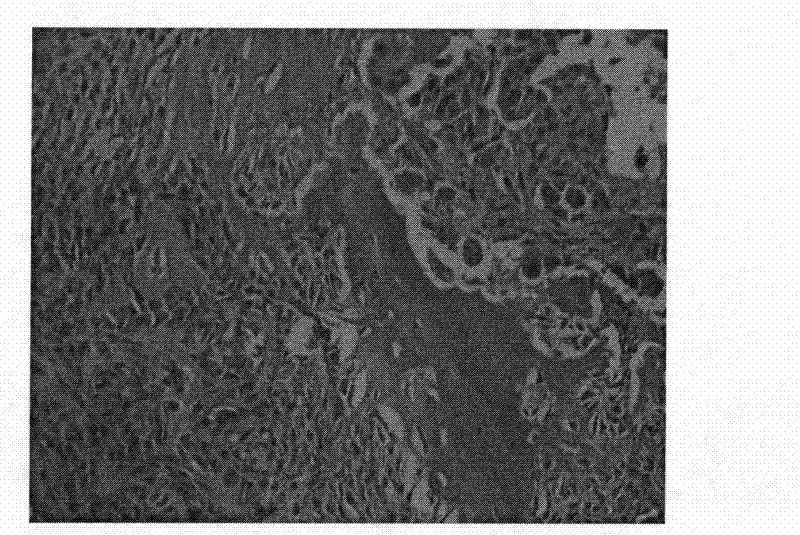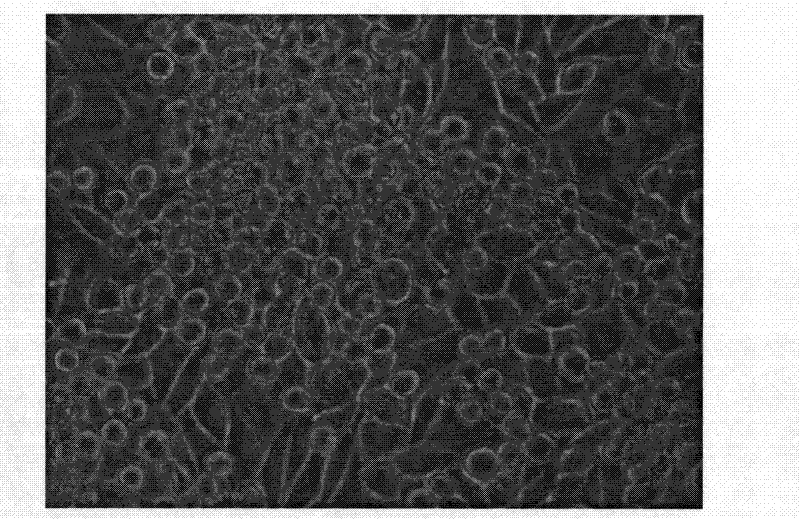Parental human lung adenocarcinoma cell line with high potential of bone metastasis
A technology of lung adenocarcinoma cell line and lung adenocarcinoma, applied in the field of parental Chinese lung adenocarcinoma cell line, can solve the problems of limited collection of clinical specimens, delayed research progress in diagnosis and treatment of bone metastasis of lung cancer, etc., to improve the level of clinical diagnosis and treatment, deepen the The effect of knowing
- Summary
- Abstract
- Description
- Claims
- Application Information
AI Technical Summary
Problems solved by technology
Method used
Image
Examples
Embodiment 1
[0040] The pericardial effusion of the patient was taken as the primary cell culture according to the conventional method, and the experimental animal immunodeficiency mice (nude mice, SCID mice, NIH-III BNX mice) were used to form metastasis after injection of the experimental mice. After the bone metastases were identified by imaging agent tracing, the diseased tissues were cultured in vitro to obtain a subset of lung cancer cells with bone metastases. The above cycle was repeated to finally obtain a parental human lung adenocarcinoma cell line with high potential for bone metastases, which was named CPA-Y1.
[0041] Analyze the biological characteristics of the above bone metastatic cells to determine the parental human lung adenocarcinoma cell lines with high potential for bone metastases, including ultrastructural comparison; cell population doubling time; karyotype analysis; tail vein, subcutaneous Injection site tumorigenicity, metastasis and specificity.
[0042] The r...
Embodiment 2
[0044] The established human lung adenocarcinoma cells (CPA-Y1) 75×104 were injected into the blood system of immunodeficiency mice, and metastasis was formed after the injection of experimental mice. After the radioisotope bone imaging agent traced and confirmed the bone metastasis, Cultured lesion tissue in vitro to obtain bone metastatic lung cancer cell subsets, repeated the above cycle, weighed every other day after two weeks, and performed radionuclide bone imaging every week from the third week. The results confirmed that the parental cells had high potential bone metastases Lung cancer cell CPA-Y1.
[0045] The medium involved is RPMI1640 or DMEM medium containing 10% calf or fetal bovine serum, pH=7, culture temperature is 37°C, 5% CO 2 .
Embodiment 3
[0047] Immunodeficient mice were injected with CPA-Y1 through the left lung, with 750,000 to 800,000 cells / mouse. Two weeks later, the lower limbs of the mice were paralyzed. After three weeks, bone metastases were found to be 90% as determined by nuclide bone imaging and pathology. And only 10% have lung metastases at the same time. Comprehensively using gene chips, real-time quantitative PCR, Western Blotting and other technologies to further analyze the functional genome related to bone metastasis of lung cancer and the genes related to bone metastasis, the results show that the CPA-Y1 cells can be used to explore the diagnosis and treatment of human lung cancer. Provide a technical platform for bone metastasis and systematic research on multiple metastases of lung cancer. At the same time, it can further deepen the understanding of the molecular mechanism of bone metastasis of lung cancer, and provide an effective molecular detection method for early diagnosis of bone meta...
PUM
 Login to View More
Login to View More Abstract
Description
Claims
Application Information
 Login to View More
Login to View More - R&D
- Intellectual Property
- Life Sciences
- Materials
- Tech Scout
- Unparalleled Data Quality
- Higher Quality Content
- 60% Fewer Hallucinations
Browse by: Latest US Patents, China's latest patents, Technical Efficacy Thesaurus, Application Domain, Technology Topic, Popular Technical Reports.
© 2025 PatSnap. All rights reserved.Legal|Privacy policy|Modern Slavery Act Transparency Statement|Sitemap|About US| Contact US: help@patsnap.com



